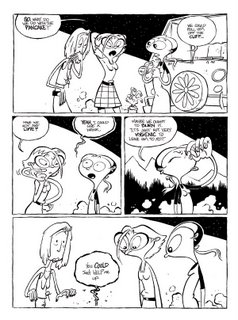
Back in 2000 when I began Chiaroscuro, my idea was to do a comic in a style that would be simple enough to do in my spare time. Ha ha.
So upon beginning the Angora Napkin comic, I put my foot down: Keep It Simple Stupid. Angora Napkin is a breather for me between Chiaroscuro hand cramps. On top of that I'm working a full time day job, a part time weekend job, home owner, husband and soon to be father of twins. My time is limited to say the least.
First thing I decided upon was portability. It's just not practical to carry around a portfolio full of illustration board, bottles of ink and all that jazz. Also, as I learned from doing a few 24 hour comics, SIZE MATTERS. So to solve these problems I picked up a pad of Strathmore smooth Bristol board (11X14). Fits nicely into my man purse and the actual drawing area is close to 8.5X11 instead of 10X15. It makes a huge difference.
I wrote a 3 page treatment for the graphic novel outlining the story in broad terms. This was very different for me as Chiaroscuro's storyline lives in my head only until I sit to write an issue. From the outline I chicken scratch the dialogue into a note book, fleshing out the story as I go along. This took place in coffee shops, my friend Patricks' wood working shop and in a truck while I waited for him to load up wood. I've highlighted the "text" I used.

Based on that, I do some thumbnails. I've pointed out the particular page I'll be focusing on (page 10).

Taking the drawing from here to the next phase is pretty organic. I use this as a base to work from and change things that I don't like, or adjust the composition. I may add, delete or change dialogue to fit the scene better as well. I've been roughing these out full size on basic copy paper with blue or red (whatever's handy) col-erase pencils and then tightening them up with a nice dark B pencil. I'll sometimes cut them apart and reassemble them, or parts of them until I generally like the poses and layout. This whole process goes pretty quick when I've got my head in the game and I get some nice energetic drawings.

I then transfer the drawing to the Bristol board and tighten up the drawing with a mechanical pencil, adding the panel boarders, dialogue, background and whatever's missing. For inking, I'm keeping portability in mind. My favorite tool for drawing lately have been my Pental pocket brush pen. I love it! I do the lettering with a rapido graph and fill in blacks using a sharpie, but pretty much everything else gets the brush.

All the stuff up to this point I do when I find a spare moment. I'm usually up and working around 6am until I have to go to the day job around 8. I'll try and get out at lunch, grab a coffee and work some more. Once and a while I do a bit of evening work and if it's not busy I'll do some thumbnail/rough work during my weekend job. I can manage about 2 pages a week at this pace, give or take.
I also tried adding spot colour to some of the pages. I had that in mind from the beginning, but whether or not the colour version is going to be used is still a question up to the publisher.
